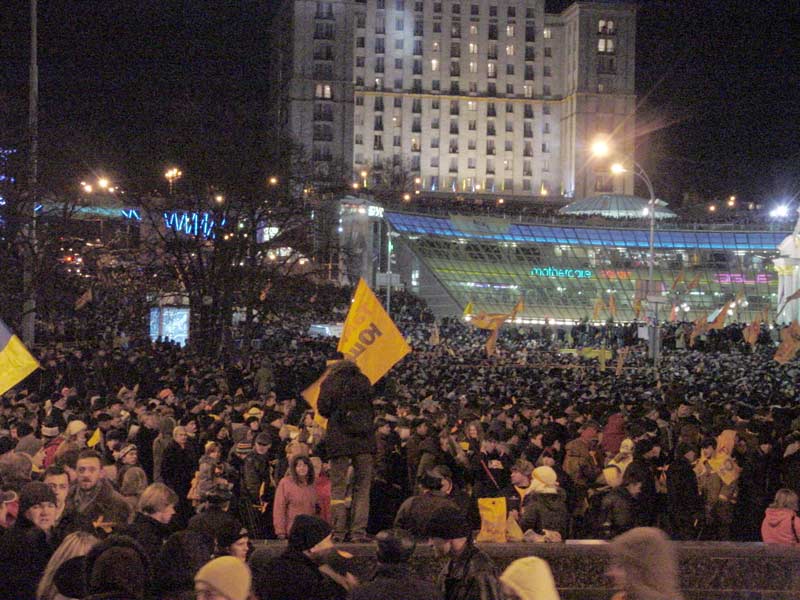
The controversial figure, President Leonid Kuchma, had ignited the public’s fury in 2000 through his infamous ‘Cassette Scandal’, wherein he ordered the murder of journalist Georgiy Gongadze, the founder of the online paper, Ukrainska Pravda. Gongadze’s assassination was fundamental in building up the momentum for the Orange Revolution, and would later come back to haunt Kuchma’s chosen ‘successor’, Viktor Yanukovych, as Ukrainians reached a breaking point. Another indicator of Ukraine’s dissatisfaction with its government appeared to be with the government’s failure to establish a concrete economy, due to lack of foreign investment, businesses being over regulated, and putting oligarchs against each other. However, it would take until the 2004 Ukrainian Election, between the pro-Western Yushchenko and pro-Russia Yanukovych, to trigger the revolution. The results were claimed to be fraudulent and rigged in favour of Yanukovych, and it was this pivotal moment that provoked the beginning of the Orange Revolution, with peaceful protests starting after the results of the second round of the election had been announced.
When evaluating American democracy assistance programmes, it is widely evident that US intervention in the Orange Revolution played a significant role in the outcome of placing Yushchenko as the Ukrainian President. We can observe US intervention mainly through their strategy of funding non-government organisations (NGOs). The role of these NGOs was to provide numerous services that would oppose the Kuchma regime and his support of Yanukovych. These NGOs would lend technical expertise through mobilising people and planning demonstrations, highlighting the US’ role in attempting to place Yushchenko as president. Furthermore, a US donor, the National Democratic Institute (NDI), sent observers to Ukraine whilst funding election observation missions that were organised by either local or foreign organisations. The NDI played a crucial role in the Orange Revolution, going beyond its initial involvement. Observers from the Central Election Commission of Ukraine identified registered NDI members actively contributing to ensuring the legitimacy of the election process.
The US Department of State and USAID, alongside the International Republican Institute, were involved in uplifting grassroots campaigns, an integral role in ousting Yanukovych. US-funded aid to assist democracy in the former Soviet sphere of influence may not have been as overt as its preceding interventions. However, it is estimated that around 14 million dollars of funding went into the aforementioned groups in order to ‘aid democracy’ and to place a pro-US candidate as president. To assume that the US singlehandedly shaped the outcome of the Orange Revolution overlooks a plethora of issues that were within Ukraine and its government, which the people believed needed amending. It is difficult to deny that the US’ role of attempting to promote democracy by funding democracy assistance programmes did not impact the outcome of the Orange Revolution. Through propping up grassroots campaigns and assisting protestors, we can observe that US intervention focused on fuelling the discontent of protestors to ensure the ascension of Yushchenko.
The murder of Gongadze had altered Ukrainian perceptions of online-based news outlets, such as Ukrainska Pravda, allowing them to be viewed as legitimate sources of news in contrast to the state’s heavily censored oligarch-run media. The role of technology in the Orange Revolution provided alternative news sources, but also allowed protestors to coordinate demonstrations, thus keeping the revolution alive. Not only could protestors coordinate demonstrations, they could possess an easily accessible platform to maintain communication, report election fraud, and set up discussion boards. Technology liberated Ukrainian protestors and played an integral part in promoting democracy; a characteristic unique to revolution in the 21st century. An example demonstrating this duality is the ‘egg incident’, wherein a protester threw an egg at Yanukovych. However, the Interior Ministry issued a statement to say that he had been hit by ‘several hard objects’. This was far from the truth, with the incident being captured on video clearly showing that it was an egg, and the Ministry’s statement was exposed to be farcical through the utilisation of technology to decipher government lies.
Another example of technology being utilised to aid revolution was in assisting pro-democracy groups such as Pora!; political networks could be established and spread information to its 72 regional centres and 30,000 registered participants. With commentators such as Michael McFaul stating that ‘the Orange Revolution may have been the first in history to be organised largely online’, thus it is evident that the digital age in which we exist enabled Ukrainians to communicate and have the freedom of expression that reserves our right to expose government corruption and promote democracy.
When isolating the varying contributors to the Orange Revolution and its outcome, US intervention, alongside technology, played a vital role in seeing the outcome of Yushchenko as the next Ukrainian President. Efforts made by Ukrainian citizens demonstrate a new age in which something as old as revolution can be modernised and adapted to our modern age to defend our rights and liberties. Of course, the role of US intervention (although always controversial) ensured, through NGOs and election observers, that the results of the election could no longer be falsified, thus securing democracy through its support of protestors. Although Yushchenko would never see a second term, with Yanukovych being elected in 2010, the gravitas of the Orange Revolution and its counterpart revolutions will serve as a reminder to the notion that exercising revolution is fundamental to living in truth.
By Leah Morris
